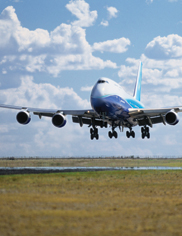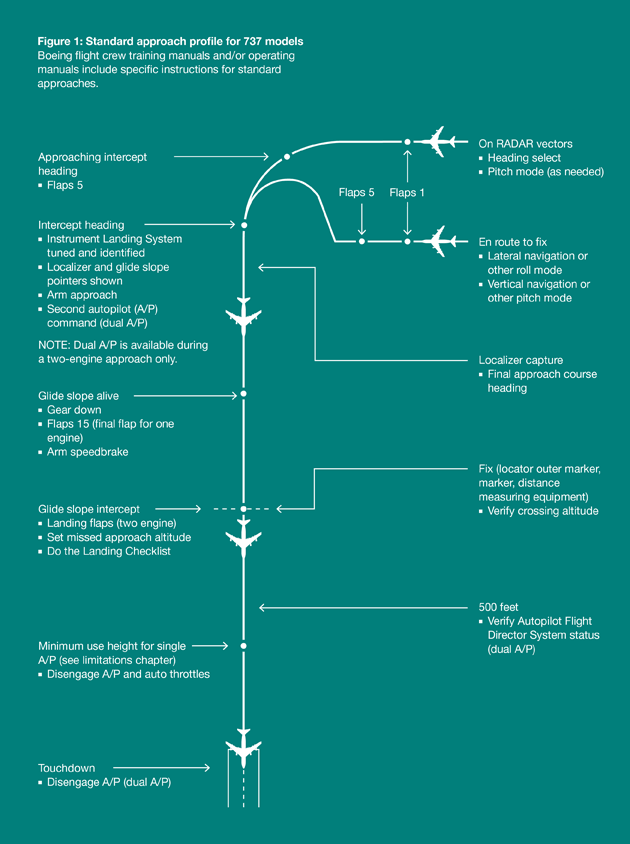

The descent and approach phases of flight represent the flight crew’s final opportunities to reduce fuel consumption during flight. By carefully planning the airplane’s descent and appropriately using drag and high lift devices, the flight crew can ensure a safe landing while saving fuel.
By William Roberson, Chief Pilot Research, and
James A. Johns,
Flight Operations Engineer, Flight Operations Engineering
Decisions on which type of approach to use vary with each airline, and sometimes even for each flight.
This article is the fourth and final in a series exploring fuel conservation strategies. It discusses strategies for saving fuel during the descent and approach phases of flight. The first article in this series, “Cost Index Explained,” appeared in the second-quarter 2007 AERO. It was followed by “Cruise Flight” in the fourth-quarter 2007 issue and “Takeoff and Climb” in the fourth-quarter 2008 issue. Download the whole series as one PDF.
Fuel conservation is a significant concern of every airline. An airline can choose an approach procedure and flap setting policy that uses the least amount of fuel, but it should also consider the trade-offs involved with using this type of procedure.
In this article, two types of approaches are analyzed: the standard approach and the low-drag or delayed-flaps approach. The cost of a missed approach is also discussed.
The standard approach
Boeing flight crew training manuals and/or flight crew operating manuals (FCOM) define standard approach profiles for every Boeing model. These profiles include specific flap settings and when to select them during various parts of the approach (see fig. 1).
Figure 1: Standard approach profile for 737 models
Boeing flight crew training manuals and/or operating manuals include specific instructions for standard approaches.

The low-drag or delayed-flaps approach
If the approach is not being conducted in adverse conditions that would make it difficult to achieve stabilized approach criteria, the final flap selection may be delayed until just prior to 1,000 feet above field elevation (AFE) to conserve fuel and reduce noise and emissions or to accommodate speed requests by air traffic control. This approach is known as a low-drag, delayed-flaps, or noise-abatement approach. The actual steps to use vary by airplane model and are described in the FCOM, flight crew training manual, or airline standard operating policy. These are the general steps for the 737, 757, 767, and 777:
- 737: Intercept the glide slope with gear down and flaps 15 at flaps 15 speed. 757/767/777: Intercept the glide slope with gear down and flaps 20 at flaps 20 speed.
Note: The thrust required to descend on the glide slope may be near idle. - Approaching 1,000 feet AFE, select landing flaps, reduce the speed to the final approach speed, and then adjust thrust to maintain it.
- Perform the Landing Checklist.
Note for the 757/767/777: In particularly noise-sensitive areas, use the technique above but delay extending the landing gear until 1,500 feet AFE.
Fuel savings associated with delayed-flaps approach
Depending on the flap setting and airplane model, the delayed-flaps approach uses 15 to 380 fewer pounds of fuel than the standard approach with the same flap setting (see fig. 2). To repeat, this approach should only be conducted in conditions that do not make it difficult to achieve a stabilized approach criteria.
Figure 2: Fuel savings estimates for delayed-flaps approach procedure
The delayed-flaps approach uses 15 to 380 fewer pounds of fuel than the standard approach with the same flap setting.
AIRPLANE ENGINE |
LANDING WEIGHT LBS (KG) |
LANDING FLAP (DEG) |
PROCEDURE |
FUEL BURNED LBS (KG) |
FUEL |
|
737-800 CFM56-7B24 |
120,000 (54,431) |
30 |
Standard |
230 (104) |
|
|
Delayed |
213 (97) |
17 (8) |
|||
|
40 |
Standard |
266 (121) |
|||
|
Delayed |
230 (104) |
36 (16) |
|||
|
747-400 CF6-80C2B1F |
450,000 (20,411) |
25 |
Standard |
590 (268) |
|
|
Delayed |
540 (245) |
50 (23) |
|||
|
30 |
Standard |
610 (277) |
|||
|
Delayed |
550 (250) |
60 (27) |
|||
|
767-300 CF6-80C2B4 |
270,000 (122,469) |
25 |
Standard |
400 (181) |
|
|
Delayed |
370 (168) |
30 (14) |
|||
|
30 |
Standard |
440 (200) |
|||
|
Delayed |
390 (177) |
50 (23) |
|||
|
777-200 GE90-94B |
450,000 (204,411) |
25 |
Standard |
850 (385) |
|
|
Delayed |
790 (358) |
60 (27) |
|||
|
30 |
Standard |
920 (417) |
|||
|
Delayed |
820 (372) |
100 (45) |
The cost of a missed approach
Although reduced-flap, delayed-flap, or low-drag approach procedures can save an airline significant amounts of fuel over time, if these procedures are inappropriately applied resulting in a missed approach, the subsequent additional fuel burn required for the missed approach and additional flight pattern will nullify all the fuel saving efforts employed on the entire flight. It cannot be overemphasized that the first priority of the crew is to fly the descent and approach safely and to be in a position to land at the appropriate time.
The typical missed-approach procedure is to apply go-around thrust, retract the flaps and gear while climbing to a minimum of 1,500 feet AFE, and accelerate to a minimum of flaps-up maneuvering speed. Depending on the airplane model and landing flap configuration, the fuel burned during one missed approach is equivalent to 2 to 28 times the fuel burn required for a descent and approach (see fig. 3). There will also be the fuel required to fly an additional traffic pattern.
Figure 3: Additional fuel burn attributed to missed approaches
The fuel burned during one missed approach is equivalent to 2 to 28 times the fuel burn required for a descent and approach.
AIRPLANE/ENGINE |
ADDITIONAL FUEL BURN LBS (KG) |
|
737-800 CFM56-7B24 |
280 (127) |
|
747-400 CF6-80C2B1F |
1,400 (635) |
|
767-300 CF6-80C2B4 |
610 (277) |
|
777-200 GE90-94B |
880 (399) |
Summary
Flight crews can vary their approach procedures and flap selections to match the flight’s strategic objectives, which almost always include fuel conservation, noise abatement, and emissions reduction. Decisions on which type of approach to use vary with each airline, and sometimes even for each flight.
Boeing Flight Operations Engineering assists airlines’ flight operations departments in planning low-drag approaches for any airport in the world. For more information, please contact FlightOps.Engineering@boeing.com.


